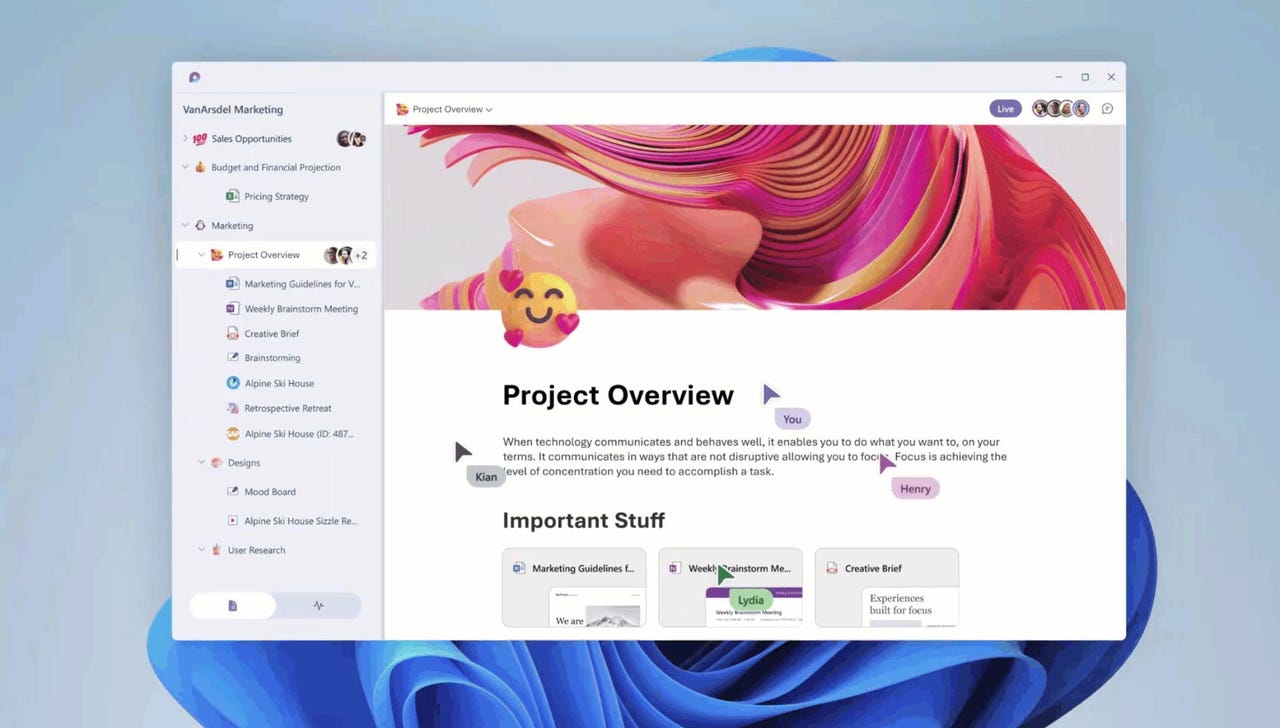































 Credit: Microsoft
Credit: Microsoft Microsoft's collaboration strategy for the past few years has largely revolved around Teams. But there's more than one way to collaborate, and, as of this week, another Microsoft collaboration app is in the mix.
At its Ignite IT Pro conference this week, Microsoft is rebranding many (but not all) of its Fluid technologies as "Loop" and debuting a new standalone productivity app called Microsoft Loop. Loop builds on top of and extends Microsoft's vision for its Fluid Framework, which the company introduced in 2019 as a way to provide fast coauthoring and compound documents that included elements synced in near-real-time.
Loop the app looks and works a lot like the Notion project-management/collaboration tool in that it provides a canvas with portable components that can stay in sync across apps while users create as a team. But unlike the Notion app, Loop can be used both as a standalone app/canvas, as well as inside other apps in the form of embeddable components; a Microsoft spokesperson told me when I asked about the similarities. These Loop components will be built into other Microsoft apps like Outlook, Teams, OneNote, and/or Whiteboard.
As Loop components roll out starting in November 2021, they will be built into existing Office apps across Microsoft 365 commercial licenses, a company spokesperson said. Over time, Loop components will appear in Teams, OneDrive, Office.com, and the Office mobile apps. Microsoft is not ready to talk about licensing/pricing for the standalone Loop app, but the spokesperson added that it will have more to share in 2022 when it rolls out.
Loop components are the renamed and updated Fluid components -- tables, notes, tasks, or even a customer-sales record in Dynamics 365 -- that can be embedded in chats, emails, meetings, documents, or pages. Information stored in a Loop component will automatically and rapidly sync, so users will always have access to the latest, regardless of where the component is located. Loop pages are "flexible canvases" in Microsoft's words, where users can organize project components like files, links, and data. Loop workspaces are shared spaces where teams can keep track of all the aspects of a project and where individuals can collaborate asynchronously or synchronously.
At Ignite this week, Microsoft is adding a couple of additional Loop components. One is a voting table for teams; another is a status tracker for gathering team information, tracking the progress of projects, and providing the latest status of a project. Officials said these two new components will be available within Teams chats for Microsoft 365 customers starting this month.
Previously announced Fluid Framework components, including agenda, notes, and task lists, will be available soon. They'll be rebranded as Loop components as part of the coming meeting-notes options in Outlook, Teams, and OneNote, officials said. The idea is that by adding meeting notes to calendar invitations in Outlook or Teams, users will be able to start collaborating with other participants ahead of the start of a meeting and following its ending, as well.
Earlier this year, Microsoft officials showed how Fluid components could supplement Microsoft Whiteboard and make the collaboration process even richer. At that time, Microsoft hadn't yet announced the Loop brand, but the vision remains the same, with the recently updated Microsoft Whiteboard app providing an even more robust hosting environment for Loop components.
When I asked this week about the relationship between Whiteboard and Loop, a Microsoft spokesperson provided the following context:
"Whiteboard is a great tool for working together in a deeply visual and immersive way. It's also one of the many M365 app experiences that will host Loop components and become one. For example, in your Loop app you'll be able to create new whiteboards with a single click, allowing you to kick off a collaborative brainstorm session right from within your Loop page. And because a Whiteboard could be used as a Loop component, you will be able to see that same whiteboard live and in-sync from within Teams, Outlook, or anywhere else Loop components are supported. That allows your team to think and create together no matter which app they're using in the moment."
According to Microsoft, third-party developers will be able to build their own Loop components by "extending their existing message extensions apps and Graph Connector integrations with minimal investments." Microsoft plans to talk more about how this will work at its Build developers conference next year.
 Горячие метки:
По вопросам бизнеса
Компании-производители
Горячие метки:
По вопросам бизнеса
Компании-производители